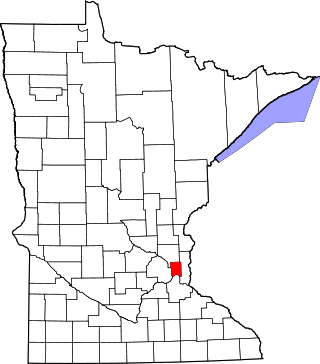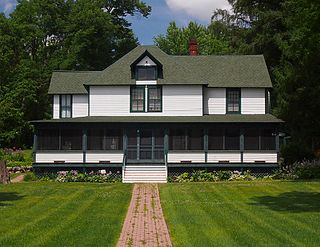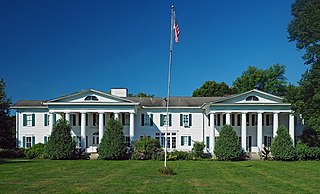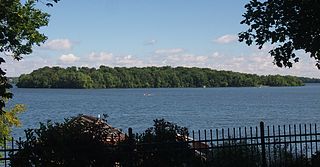
Cottage Grove is a city 10 miles (16 km) south of Saint Paul in Washington County in the state of Minnesota. It lies on the north bank of the Mississippi River, north of the confluence with the St. Croix River. Cottage Grove and nearby suburbs form the southeast portion of Minneapolis-Saint Paul, the 16th-largest metropolitan area in the United States, with about 3.69 million residents. Its population was 38,839 at the 2020 census.

White Bear Lake is a city in Ramsey County in the state of Minnesota, United States. A small portion of the city also extends into Washington County. The population was 24,883 at the 2020 census. The city is located on White Bear Lake, one of the largest lakes in the Minneapolis–Saint Paul metropolitan area. The lake is a large lake that is home to many different species of fish including largemouth bass, smallmouth bass, northern pike, and a variety of other species.

Charles A. Lindbergh State Park is a 569-acre (2.3 km2) Minnesota state park on the outskirts of Little Falls. The park was once the farm of Congressman Charles August Lindbergh and his son Charles Lindbergh, the famous aviator. Their restored 1906 house and two other farm buildings are within the park boundaries. The house, a National Historic Landmark, and an adjacent museum are operated by the Minnesota Historical Society, known as the Charles Lindbergh House and Museum. Three buildings and three structures built by the Works Progress Administration in the 1930s were named to the National Register of Historic Places. These buildings include a picnic shelter and a water tower, built in the Rustic Style from local stone and logs, and have remained relatively unchanged since construction. Although the property includes shoreline on the Mississippi River, the Lindbergh family requested that the park not include intensive use areas for swimming or camping, so development was kept to a minimum.

This is a list of sites in Minnesota which are included in the National Register of Historic Places. There are more than 1,700 properties and historic districts listed on the NRHP; each of Minnesota's 87 counties has at least 2 listings. Twenty-two sites are also National Historic Landmarks.

This list is of the properties and historic districts which are designated on the National Register of Historic Places or that were formerly so designated, in Hennepin County, Minnesota; there are 194 entries as of November 2024. A significant number of these properties are a result of the establishment of Fort Snelling, the development of water power at Saint Anthony Falls, and the thriving city of Minneapolis that developed around the falls. Many historic sites outside the Minneapolis city limits are associated with pioneers who established missions, farms, and schools in areas that are now suburbs in that metropolitan area.

This is a complete list of National Register of Historic Places listings in Ramsey County, Minnesota. It is intended to be a complete list of the properties and districts on the National Register of Historic Places in Ramsey County, Minnesota, United States. The locations of National Register properties and districts for which the latitude and longitude coordinates are included below, may be seen in an online map.

The Cyrus B. Cobb House is a home built circa 1885 in White Bear Lake, Minnesota. Originally built as a private residence for C.B. Cobb, a prominent White Bear Lake businessman and lumber dealer, the home later served as a rectory for a local church, was known as White Bear Lake Tavern from 1912 to 1923, and a private residence. The solid brick house was designed in the Queen Anne architectural style and is one of the few substantial year-round brick homes remaining in the community. It is the only private home in White Bear Lake on the National Register of Historic Places.

The Crane Island Historic District is a historic district of vacation properties on Crane Island in Lake Minnetonka, part of the city of Minnetrista, Minnesota, United States. It consists of a number of private residential summer cottages and some communal amenities. Although it was originally developed by parishioners of the Presbyterian Church, it is now a secular association that welcomes all. The island was designated a historic district and listed on the National Register of Historic Places in 1991.

The Loren L. Chadwick Cottages are two cottages in the Linden Hills neighborhood of in Minneapolis, Minnesota, United States, situated roughly south of Bde Maka Ska and northwest of Lake Harriet. This area of Minneapolis was platted in 1882-83 as "Cottage City" by a local real estate developer, Louis F. Menage. He platted small 25 feet (7.6 m)-wide lots, as opposed to the normal lot width of 40 feet (12 m), in an effort to attract people who wanted to build summer lake cottages.

The Minnesota Home School for Girls was a reformatory in Sauk Centre, Minnesota, United States. It was Minnesota's first single-sex reformatory for girls from its establishment in 1911 to 1967, when it switched to a coeducational model and shortened its name to the Minnesota Home School. The facility closed in 1999. The campus was designed on the Cottage Plan, with dispersed buildings in a bucolic setting, by Minnesota state architect Clarence H. Johnston Sr. The site has been converted to a veteran care center called Eagle's Healing Nest.

This is a list of the National Register of Historic Places listings in Wabasha County, Minnesota. It is intended to be a complete list of the properties and districts on the National Register of Historic Places in Wabasha County, Minnesota, United States. The locations of National Register properties and districts for which the latitude and longitude coordinates are included below, may be seen in an online map.

This is a list of the National Register of Historic Places listings in Washington County, Minnesota. It is intended to be a complete list of the properties and districts on the National Register of Historic Places in Washington County, Minnesota, United States. The locations of National Register properties and districts for which the latitude and longitude coordinates are included below, may be seen in an online map.

This is a list of the National Register of Historic Places listings in Wright County, Minnesota. It is intended to be a complete list of the properties and districts on the National Register of Historic Places in Wright County, Minnesota, United States. The locations of National Register properties and districts for which the latitude and longitude coordinates are included below, may be seen in an online map.

The Thompson Summer House is a house in Minnetonka Beach, Minnesota, United States, listed on the National Register of Historic Places. It is located on Hennepin County Road 15, across from Lafayette Bay on Lake Minnetonka.

The Cordenio Severance House is a mansion in Cottage Grove, Minnesota, United States, built for attorney Cordenio Severance (1862–1925). The mansion, also known as Cedarhurst, was first built as a simple country farm house shortly after the American Civil War. It was expanded in 1886 to serve as the summer residence of the Severance family. Between 1911 and 1917, additions designed by architect Cass Gilbert expanded the house into a mansion with 12,000 square feet (1,100 m2) and 26 rooms. The Cordenio Severance House was listed on the National Register of Historic Places in 1976 for its local significance in the themes of architecture and law. It was nominated for its association with Cordenio Severance, a leading attorney in Saint Paul, Minnesota, from 1887 to the 1920s, and for being an example of a grand country estate. The mansion now serves as an event venue.

The Hay Lake School is a historic schoolhouse in Scandia, Minnesota, United States, in use from 1896 to 1963. It is now operated by the Washington County Historical Society as a museum alongside the 1868 Johannes Erickson House. The school was listed on the National Register of Historic Places in 1970 for having local significance in the themes of architecture, education, and social history. It was nominated as Scandia's first and only surviving early school.

This is a list of the National Register of Historic Places listings in Becker County, Minnesota. It is intended to be a complete list of the properties and districts on the National Register of Historic Places in Becker County, Minnesota, United States. The locations of National Register properties and districts for which the latitude and longitude coordinates are included below may be seen in an online map.

The Johannes Erickson House is a historic log cabin in Scandia, Minnesota, United States, built in 1868 with a gambrel roof, a distinctive tradition from southern Sweden. It was moved to its current site adjacent to the Hay Lake School in 1974 to be part of a small museum complex operated by the Washington County Historical Society. The Erickson House was listed on the National Register of Historic Places in 1976 for having local significance in the themes of architecture and exploration/settlement. It was nominated as a rare surviving example of a style brought to Minnesota by Swedish immigrants from Dalsland and Småland.

Coney Island of the West is an island in Lake Waconia in the U.S. state of Minnesota that was developed into a summer resort with its heyday from the 1880s to the 1920s. It continued operating up to 1960. The 31-acre (13 ha) island is part of Waconia Township just .5 miles (0.80 km) off the shore from the city of Waconia. It was listed on the National Register of Historic Places in 1976 for its local significance in the themes of commerce and entertainment/recreation. The island site, with its ruins of hotels, cottages, and parks, was nominated for being one of Minnesota's most popular early resorts, and an early expression of the trend of urban dwellers journeying to Minnesota's lakes and parks for recreation. Lambert Naegele, Reinhold Zeglin, and Emile Amblard developed resort buildings and attractions on the island. The best preserved building from this era, however, is the Emile Amblard Guest House on the mainland.

The Virginia–Rainy Lake Lumber Company Manager's Residence is a historic house in Virginia, Minnesota, United States. It was built in 1910 to provide upscale quarters for the manager of the Virginia–Rainy Lake Lumber Company, the largest lumber company in the area. The house was listed on the National Register of Historic Places in 1980 for its local significance in the themes of industry and social history. It was nominated for reflecting the social distance enforced between industry elites and laborers in the early 20th century. The city's working class population at the time was crowded into boarding houses and small cottages, and it was common for large companies to erect lavish residences for their managerial class in the belief that telegraphing class distinctions was essential for maintaining workforce discipline.






















